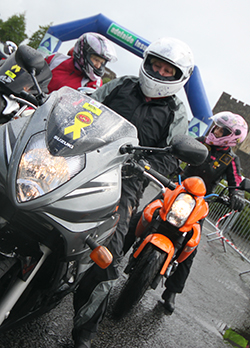
Earlier this year Right To Ride put together a survey – The Rider’s Perspective – to gauge the views of riders about the potential dangers that they face on the roads, training, risk, collisions as well as their opinions about two motorcycle safety campaign videos which were put out by the Department of the Environment (DOE) in Northern Ireland.
The videos, which are still being show on local TV, social media (DOE – Share The Road To Zero) were also promoted in cinemas, with according to the DOE, two key messages:
The first video, “Bike Speed” urges bikers to think about the emotional wreckage they will leave behind if they feel the need to speed. The core message to motorcyclists in this video is “It’s not just you who crashes.”
The second video, “Biker Aware”, aims to encourage drivers to pay attention, to take another look, to show consideration, to look really closely with road collision scenarios showing what we assume are fatal collisions. The core message in this video to drivers is “Take another look”.
While the videos have been generally accepted by the riding and driving population of Northern Ireland and shared by others outside Northern Ireland, on Social Media, attitudes and belligerent statements appeared to have created a “them and us” situation of Riders versus Drivers.
These videos, along with other developments at the time and since, were part of the DOE Road Safety Unit of Northern Ireland’s attempt to “reduce casualties” and to change the behaviour and attitudes of motorcyclists.
The Rider’s Perspective Survey
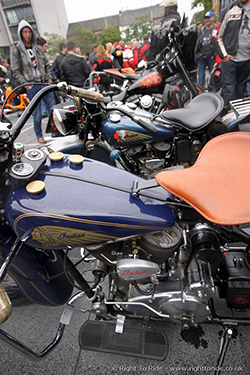 The Rider’s Perspective survey was completed by 323 riders across the UK – England 43% – Northern Ireland 39.6% – Scotland 12.7% – Wales 2.5% – Channel Islands 0.3% – Other (not UK) 1.2% – 0.6% gave no answer.
The Rider’s Perspective survey was completed by 323 riders across the UK – England 43% – Northern Ireland 39.6% – Scotland 12.7% – Wales 2.5% – Channel Islands 0.3% – Other (not UK) 1.2% – 0.6% gave no answer.
The survey includes information in relation to riders’ attitudes and behaviour on the roads. It also includes information regarding collisions, injuries, training and riders’ reaction to the DOE videos. Videos and publicity that typically put out by the DOE demonstrate scenes of carnage and coffins and appear to aim to create a sense of guilt and blame for those who have either caused injuries or death.
You can download the survey results below in which we have highlighted the important data and you can read through riders’ responses:
• If they had a collision who they thought was responsible.
• What point they thought a scene in one of the DOE videos was is attempting to make? The ending of the video shows a coffin with a helmet on the lid and what appear to be grieving relatives standing next to it.
• If they had been given the opportunity to make this video, what would their ending have been.
• General comments to the videos and the survey.
The most relevant question asked in relation to the DOE’s road safety campaign targeting motorcyclists was whether the videos shown would influence riders to change their style of riding.
Overall, the respondents gave balanced and interesting answers: 56 motorcyclists or 17.3% answered that they would change their style of riding., while 62% or 200 of the respondents indicated that they would not change their style of riding – i.e. the videos made no difference.
Rider’s Perspective Survey – pdf – 462kb – Click Here
Although we realise that the DOE videos are only one step in an attempt to deliver a strategy for Motorcycle Safety in Northern Ireland, the videos were produced without any input (though not for the want of trying), from the Motorcycle Safety Forum stakeholders.
This forum is made up of different rider organisations, trainers, police, DOE and other government agency representatives and has over the past five years, looked at delivering a motorcycling safety strategy for Northern Ireland.
However a draft Proposal for Action Measures from the DOE Road Safety Unit combined with “research” findings from a market research company commissioned by the same Road Safety Unit, led to our withdrawal of support for this forum and as a consequence justified (we think) our response to the DOE about what we considered their insular “attitude” regarding riders of motorcycles.
What surprised us was that this marketing company has an excellent reputation for professional, quality research, so we were of the opinion, that the researchers of the company had been given a specific brief by the DOE department responsible for Road Safety.
The Market Research
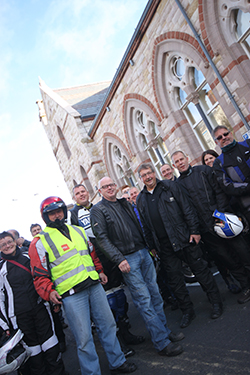 The purpose of the market research, as far as we understood it, was to glean information from motorcyclists in Northern Ireland in order to reduce road casualties amongst Powered Two Wheeler (PTW) users. Or so it seemed.
The purpose of the market research, as far as we understood it, was to glean information from motorcyclists in Northern Ireland in order to reduce road casualties amongst Powered Two Wheeler (PTW) users. Or so it seemed.
Originally this “research” was an in depth study with focus groups and individual interviews, (in fact, Right To Ride took part in a one on one interview session with the market research company), to identify areas of concern in motorcycle accident causation.
However, having read the findings of the “research”, in our opinion, it seemed to have masked the real objectives which was to carry out psychological profiling of motorcyclists in Northern Ireland in order to identify “bikers” (the term used by the “researchers”) as irresponsible elements in Northern Ireland society.
The market research company’s stated objectives in this study were “To explore and understand attitudes and behaviours in respect of Motorcycling and to make recommendations in respect of interventions”.
Along with a motorcycle trainer from the UK we critiqued the research report and found that the only feasible explanation we could deduce from this “research” is what appears to be an attempt by the DOE Road Safety Unit, to separate a community of people who use motorcycles, scooters and mopeds as a mode of transport, from the rest of society by intimating that “biking” is an addiction, thus these PTW users are oblivious to responsible road usage and to the dangers of crashing and subsequent injury.
Psychological Profiling
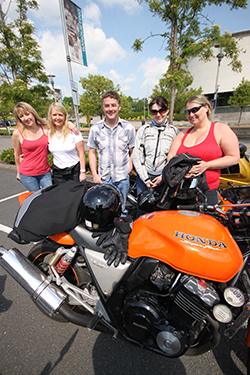 What seems apparent to us is that the psychological profiling of the individuals interviewed appears to have been interpreted as representing all PTW users in Northern Ireland and as such infers that all PTW users in Northern Ireland are problematic.
What seems apparent to us is that the psychological profiling of the individuals interviewed appears to have been interpreted as representing all PTW users in Northern Ireland and as such infers that all PTW users in Northern Ireland are problematic.
The draft Motorcycle Strategy presented to the Motorcycle Safety Forum by the DOE Road Safety Unit, contained a heading “Motorcycling Problems”. This in combination with the findings from the “research” of PTW users in Northern Ireland, seemed to suggest that solutions for these “problems” were required.
However what is very similar in terms of focusing on a problematic section of society is what has been identified by sociologists and criminologists as “The Underclass”.
It would appear that this “sectioning” has been adapted by the DOE Road Safety Unit and consequently the researchers who carried out the interviews of “bikers”, to infer that a section of society in Northern Ireland (PTW users) need to be treated as a problem in order to enable the Road Safety Unit to propose draconian measures to restrict motorcycling and PTW users (Bikers) due to their so called “bad” behaviour.
DOE Road Safety Unit, Proposed Action Measures to reduce motorcyclist casualties
The selected proposed actions below seem to indicate that the Road Unit had not discussed these measures with the stakeholders who are competent in the areas of intervention mentioned.
Comments have been made by Right To Ride to each of the proposed Action Measures:
1. Consider aligning A1 and AM riders (with CBT certificates) with A2 and A riders by insisting they are also accompanied at all times as GDL will remove the 45 mph speed restriction from learner riders.
Comment: Apart from the impracticality and expense of accompanied riders for those that have passed their CBT, AM riders i.e. moped riders cannot ride faster than 28 mph – because that is the maximum speed that this vehicle can achieve – so with all the will in the world (unless the moped is tampered with) these AM licence riders are not able to achieve a speed of 45 mph!
2. Investigate the effectiveness of the mandatory wearing of CE approved armour in motorcycle clothing.
Comment: How does the DOE Road Safety Unit intend to enforce this? The armour is usually inside compartments inside lining and would require the owner to 1) take the jacket off, 2) remove the lining 3) pull the armour out of the compartments 4) require the police officer to have the knowledge of CE standards for Personal Protective Equipment or a reliance on an understanding of labelling in jackets?
3. Consult on mandating wearing of helmets on tricycles as well as quadricycles.
Comment: This has already been put out to public consultation and is being discussed through the Road Traffic Amendment Bill in the NI Assembly, why mention it again? Was the DOE Road Safety Unit not aware of this?
4. Promote the importance of wearing high visibility clothing by running pilot scheme providing high visibility vests to motorcyclists.
Comment: How is it possible to run a pilot scheme of this nature? Apart from the prohibitive cost, there does not appear to be a specific CEN standard for this type of garment for a motorcyclist, other than the same standard on quality/purpose that a cyclist, pedestrian or builder would wear, more to the point, what does the DOE Road Safety Unit aim to achieve with this scheme? – see below.
5. Introduce regulations for the mandatory wearing of high visibility upper body clothing.
Comment: The motorcycle industry commenced the introduction of AHO in 2003 which means that almost all motorcycles have headlights on permanently in order to improve the visibility of motorcycles in traffic and this will be mandatory as of 2016. In spite of this, other vehicle drivers still pull out in front of motorcyclists at junctions.
However, there are numerous studies to highlight the issue of conspicuity and inattentional blindness, the most recent study regarding High Visibility clothing from TRL NZ which the DOE Road Safety Unit mentioned in the Draft Motorcycle Strategy paper, BUT – for whatever reason, failed to include the comment from that study that “there are limitations to all interventions, not least because conspicuity typically depends on a high visual contrast with the background, and this can vary from situation to situation”.
6. Target enforcement on popular motorcycle routes to ensure safe motoring for all road users.
Comment: These routes are not necessarily where motorcyclists crash, does the DOE Road Safety Unit have information which indicates which routes are the most dangerous for motorcyclists? Which body would be responsible for this enforcement? Also note that BikeSafe already has a scheme where they talk to and provide information motorcyclists coming to Northern Ireland for the NW 200 about road safety – was the DOE Road Safety Unit aware of this?
7. Investigate safety impacts of measures addressing congestion and motorcycle interactions with other road users (e.g. lane filtering).
Comment: This comment suggests that there seems to be an issue with filtering in traffic, it’s not clear what this action measure aims to do. Filtering is recognised as a means of reducing congestion and actually increases the safety of the motorcyclist by allowing him/her the opportunity to “get out of harm’s way” and is included already in the Highway Code with advice for motorcyclists and other vehicle users. Is there an agenda to look at the continued use of bus lanes by powered two wheelers?
8. Work with PSNI in improving the detail, accuracy and reliability of motorcyclist and casualty data. This could include information on impairment (alcohol, drugs and fatigue) and the engine size of motorcycles involved in collisions.
Comment: Information regarding alcohol and drugs is available in cases where there are casualties and surely details regarding engine size is also available, if not specifically in recording engine size but through the make and model. How does the DOE Road Safety Unit intend to measure fatigue?
9. New riding syllabus to address how attitude and behaviour influence riding (GDL – Graduated Driving Licence)
Comment: This action needs to be clarified. Does the DOE Road Safety Unit mean hazard awareness, or – and this is a legitimate question – will the new rider or as this is through GDL – all learners – be subjected to videos of carnage and death in order to become a “safer” PTW user/driver?
10. Research best practice in order to identify viable survey methods to record and report motorcycle speeds and hence quantify and assess the level of non-compliance to enable more targeted enforcement strategies.
Comment: Done! – 323 motorcyclists of all ages, sex etc (the majority of the responses from Northern Ireland) have replied to the survey “Riders’ Perspective Survey) – questions include speed, accident information, attitude and behaviour and so forth. This survey will not cost the DOE Road Safety Unit a penny while providing valuable information in order to put together a worthwhile Motorcycle Strategy for Northern Ireland.
Conclusion
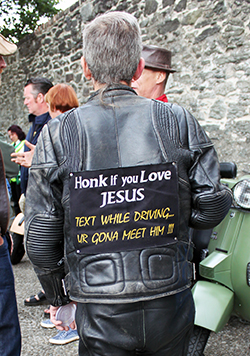 In seems that the DOE Road Safety Unit views the motorcycling community as problematic and has effectively highlighted elements which even normal PTW users would consider not representative of the wider sector of PTW users in Northern Ireland, or indeed anywhere.
In seems that the DOE Road Safety Unit views the motorcycling community as problematic and has effectively highlighted elements which even normal PTW users would consider not representative of the wider sector of PTW users in Northern Ireland, or indeed anywhere.
Because equally representative of PTW users are two well-known Northern Ireland members of parliament, trainers, police, ambulance workers, road traffic collision investigators, solicitors and as mentioned, people who use their motorcycling “hobby” to raise huge sums of money for good causes.
On a more worrying note, is that there appears to be the notion that the DOE Road Safety Unit knows better.
A powered two wheeler – i.e. a motorcycle, scooter or moped is a means of personal transport, used by different people for different reasons by 30 million citizens throughout Europe.
It should not be the responsibility of any government department to pass judgement on the reason, whether this is emotional, financial or simply because it suits them, as to why people choose one form of transport over another, but simply to offer solutions to ensure the safety and security of society to benefit from their choices.
Riders’ Perspective Survey
 Having thrown in the towel – i.e. withdrawing from the Motorcycle Safety Forum and our collaboration with the DOE’s Road Safety Unit, we discussed the outcome of their research, proposed actions etc with colleagues.
Having thrown in the towel – i.e. withdrawing from the Motorcycle Safety Forum and our collaboration with the DOE’s Road Safety Unit, we discussed the outcome of their research, proposed actions etc with colleagues.
In particular Duncan MacKillop, a UK motorcycle trainer, made salient observations regarding the “research” findings.
He commented:
“The object of the research was “To explore and understand attitudes and behaviours in respect of Motorcycling and to make recommendations in respect of interventions”.
The presumption is that the research was done in order to find ways of reducing the motorcycle casualty rate although that is not mentioned anywhere in the document. If that assumption is correct then the first and most fundamental error in the document is the additional assumption that the attitudes and behaviours of riders have anything whatsoever to do with motorcycle accidents. This is quite literally a fatal assumption to make especially in the light of the latest knowledge and understanding about accident causation.”
Furthermore with regards advertising, MacKillop highlighted issues from the “research” recommendations:
“Advertising is without doubt universally accepted by this sample as the optimum medium through which the vast majority of the motorcycling population can be reached, and it is recommended therefore that the focus on advertising should be enhanced”.
He concluded that “Whatever advertising campaign is finally devised there can only be one measurement of its success, a reduction in the number of casualties. To date most advertising campaigns have been considered a success if they gather a number of Facebook ‘likes’ or some other nebulous metric. This however is just delusional and shows a cavalier disregard for the public purse.
It might pay to re-state the foundation truths of all successful advertising which are:
1) All good selling is serving.
2) People buy only to get benefits.
3) Benefits must be supported by features.
Traditional motorcycle road safety advertising has never been quite clear on its purpose and so the target market has also been confused as to what they are actually being asked to do or how to respond. Any future advertising must serve its target audience and not be done merely to serve the requirements of the organisation placing the advertisements. Any future advertising must give the target audience a clear indication of exactly what benefits will accrue to them should they respond to the advertisement.
Any future advertising must support those benefits by explaining how and why those benefits will be gained by the individuals concerned. Failure to do any of that would be a criminal waste of money, would have no effect on the target audience and most importantly of all would ensure that motorcyclists kept on crashing in exactly the same ways and for exactly the same reasons that they have crashed in the past.
A well researched and constructed advertising campaign has the capability of making a huge difference to the casualty rate and will ensure that it’s a win-win for everybody concerned.
There is much that needs to be done by the authorities before they can fully understand the accident causation process and without that understanding any advertising campaign is almost certain to be based on a false premise.
The knowledge and understanding needed to actually reduce the motorcycle casualty rate is relatively easy to obtain and all that it requires is that somebody starts asking what it is before making any decisions. To proceed with any campaign without full and easily obtained knowledge of the problem is not a good way of running any campaign let alone one where people’s lives are at stake”.
Good Health And A Long Life
We would like to think that our participation in the Motorcycle Safety Forum and generally in motorcycle safety issues in Northern Ireland has made a difference since our involvement which started in 2009, in order to improve conditions for and recognition of riders as responsible road users in this region.
However based on the actions and attitude of the Civil Servants (some but not all) in charge of Road Safety Education in Northern Ireland – that we have dealt with, we came to the conclusion that sadly, we failed.
This is our final document on motorcycle issues in Northern Ireland – we are closing down Right To Ride.
We wish our fellow riders good health and a long life.
Ride Free!
Links & Information
Rider’s Perspective Survey – pdf – 462kb – Click Here



Speak Your Mind